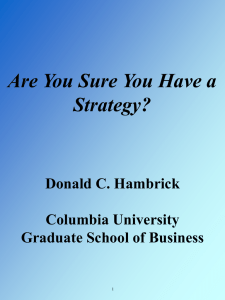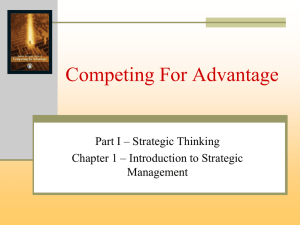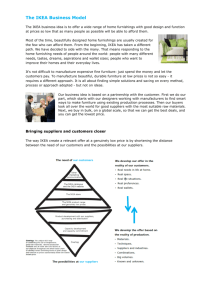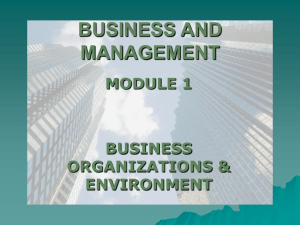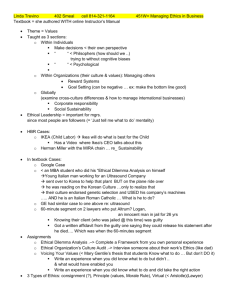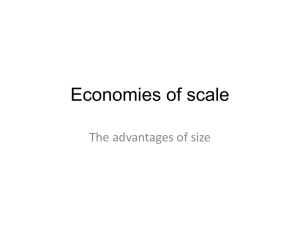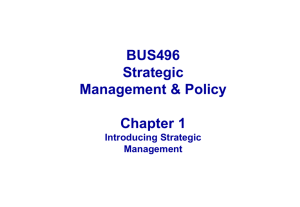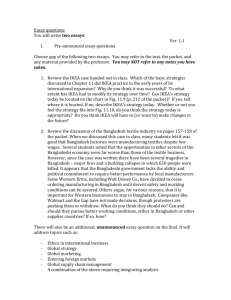Are you sure you have a strategy?
advertisement
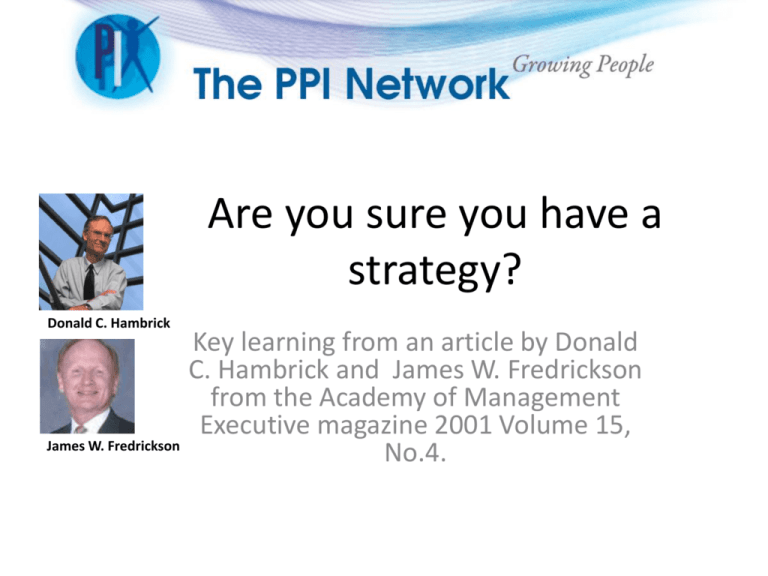
Are you sure you have a strategy? Donald C. Hambrick Key learning from an article by Donald C. Hambrick and James W. Fredrickson from the Academy of Management Executive magazine 2001 Volume 15, James W. Fredrickson No.4. Strategic threads and not Strategy! • “Our strategy is to be the low-cost provider.” • “We’re pursuing a global strategy.” • “The company’s strategy is to integrate a set of regional acquisitions.” • “Our strategy is to provide unrivaled customer service.” • “Our strategic intent is to always be the firstmover.” • “Our strategy is to move from defense to industrial applications.” • • • • • • Frameworks for analysing strategic situations Five forces analysis, Core competencies, Hyper-competition, The resource-based view of the firm, Value chains, and a host of other helpful, often powerful, analytic tools. • Missing, however, has been any guidance as to what the product of these tools should be—or what actually constitutes a strategy. • When executives call everything strategy, and end up with a collection of strategies, they create confusion and undermine their own credibility. They especially reveal that they don’t really have an integrated conception of the business. • How does knowing that their firm is pursuing an “acquisition strategy” or a “first-mover strategy” help the vast majority of managers do their jobs or set priorities? Strategy • Strategy is derived from the Greek strategos, or “the art of the general.” • Business generals, whether they are CEOs of established firms, division presidents, or entrepreneurs, must also have a strategy— a central, integrated, externally oriented concept of how the business will achieve its objectives. Without a strategy • time and resources are easily wasted on piecemeal, disparate activities; • mid-level managers will fill the void with their own, often parochial, interpretations of what the business should be doing; and the result will be a potpourri of disjointed, feeble initiatives. Examples of lacking a coherent strategy Sears • Once a towering force in retailing, Sears spent 10 sad years vacillating between an emphasis on hard goods and soft goods, venturing in and out of ill-chosen businesses, failing to differentiate itself in any of them, and never building a compelling economic logic. Strategy • A strategy consists of an integrated set of choices, • but it isn’t a catchall for every important choice an executive faces. What is included and excluded from strategy Strategic Analysis The key is not in following a sequential process, but rather in achieving a robust, reinforced consistency among the elements of the strategy itself. It is not a linear process. • • • • • Industry Analysis Customer/marketplace trends Environmental forecast Competitor analysis Assessment of internal strengths, weaknesses, resources Strategy Mission • • Fundamental Purpose Values Objectives • Specified Targets Mission and objectives stand apart from and guide strategy. The central integrated, externally oriented concept on how we will achieve our objectives Choices about internal organizational arrangements are not part of strategy Supporting Organisational Arrangements • • • • • • • Structure Process Symbols Rewards People Activities Functional policies and profiles The elements of Strategy • Arenas: where will we be active? • Vehicles: how will we get there? • Differentiators: how will we win in the marketplace? • Staging: what will be our speed and sequence of moves? • Economic logic: how will we obtain our returns? Where will we be active? • Which product categories? • Which market segments? • Which geographic areas? • Which core technologies? • Which value-creation stages? Arenas What will be our speed and sequence of moves? • Speed of expansion? Staging • Sequence of iniatives? How will we obtain our returns? • Lowest costs through scale advantages? • Lowest costs through scope and replication advantages? • Premium prices due to unmatchable service? • Premium prices due to proprietary product features? Economic Logic Vehicles How will we get there? • Internal development? • Joint ventures? • Licensing/franchising? • Acquisitions? Differentiators How will we win? • Image? • Customisation? • Price? • Styling? • Product reliability? Arenas In articulating arenas, it is important to be as specific as possible about the product categories, market segments, geographic areas, and core technologies, as well as the valueadding stages (e.g., product design, manufacturing, selling, servicing, distribution) the business intends to take on. Vehicles The means for attaining the needed presence in a particular product category, market segment, geographic area, or value-creation stage should be the result of deliberate strategic choice. Differentiators A strategy should specify not only where a firm will be active (arenas) and how it will get there (vehicles), but also how the firm will win in the marketplace—how it will get customers to come its way. Differentiators – Examples • Gillette uses its proprietary product and process technology to develop superior razor products, which the company further differentiates through a distinctive, aggressively advertised brand image. • Goldman Sachs, the investment bank, provides customers unparalleled service by maintaining close relationships with client executives and coordinating the array of services it offers to each client. • Southwest Airlines attracts and retains customers by offering the lowest possible fares and extraordinary on-time reliability. Staging Staging is the speed and sequence of major moves to take in order to heighten the likelihood of success. Examples of Staging The Factors Driving Staging • • • • Resources Urgency Achievement of credibility The pursuit of early wins Economic Logic At the heart of a business strategy must be a clear idea of how profits will be generated—not just some profits, but profits above the firm’s cost of capital. Examples of Economic Logic • The New York Times is able to charge readers a very high price (and strike highly favorable licensing arrangements with on-line information distributors) because of its exceptional journalistic quality; in addition, the Times is able to charge advertisers high prices because it delivers a large number of dedicated, affluent readers. • ARAMARK, the highly profitable international food-service company, is able to obtain premium prices from corporate and institutional clients by offering a level of customized service and responsiveness that competitors cannot match. The company seeks out only those clients that want superior food service and are willing to pay for it. Examples of Economic Logic • ARAMARK— adding to its pricing leverage— uses its huge scale of operations and presence in multiple market segments (business, educational, healthcare, and correctionalsystem food service) to achieve a sizeable cost advantage in food purchases—an advantage that competitors cannot duplicate. • GKN Sinter Metals, which has grown by acquisition to become the world’s major powdered-metals company, benefits greatly from its scale in obtaining raw materials and in exploiting, in country after country, its leading edge capabilities in metal-forming processes. The imperative of strategic comprehensiveness • All five factors are important enough to require intentionality. • All five require preparation and investment – they require certain capabilities. • They must align and support each other. • After the specification of all five strategic elements then you can design all the other supporting activities that are needed to reinforce the strategy. • IKEA’s strategy over the past 25 years has been highly coherent, with all five elements reinforcing each other. • The Arenas in which IKEA operates are well defined: – the company sells relatively inexpensive, contemporary, Scandinavian-style furniture and home furnishings. – IKEA’s target market is young, primarily white-collar customers. – The geographic scope is worldwide, or at least all countries where socioeconomic and infrastructure conditions support the concept. – IKEA is not only a retailer, but also maintains control of product design to ensure the integrity of its unique image and to accumulate unrivaled expertise in designing for efficient manufacturing. • As its primary Vehicle for getting to its chosen arenas, IKEA engages in organic expansion, building its own wholly owned stores. • Differentiators - IKEA attracts customers and beats competitors by offering several important differentiators. – First, its products are of very reliable quality but are low in price (generally 20 to 30 percent below the competition for comparable quality goods). – Second, in contrast to the stressful, intimidating feeling that shoppers often encounter in conventional furniture stores, IKEA customers are treated to a fun, nonthreatening experience, where they are allowed to wander through a visually exciting store with only the help they request. – And third, the company strives to make customer fulfillment immediate. • As for Staging, or IKEA’s speed and sequence of moves, once management realized that its approach would work in a variety of countries and cultures, the company committed itself to rapid international expansion, but only one region at a time • The Economic logic of IKEA rests primarily on scale economies and efficiencies of replication. A sound strategy 1. Does your strategy fit with what’s going on in the environment? 2. Does your strategy exploit your key resources? 3. Will your envisioned differentiators be sustainable? 4. Are the elements of your strategy internally consistent? 5. Do you have enough resources to pursue this strategy? 6. Is your strategy implementable? Is Strategy still relevant? • First, a strategy need not be static: it can evolve and be adjusted on an ongoing basis. • Second, a strategy doesn’t require a business to become rigid. • Third, a strategy doesn’t deal only with an unknowable, distant future.
